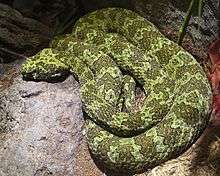Protobothrops mangshanensis
Protobothrops mangshanensis, commonly known as the Mangshan pitviper, Mt. Mang pitviper, or Mang Mountain pitviper,[4] is a venomous pit viper species endemic to Hunan and Guangdong provinces in China.[1][2] No subspecies are currently recognized. This is a nocturnal pit viper that is also known as the ''Mangshan iron-head snake'', ''Chinese pit viper'', and the ''Ironhead viper''. They eat frogs, birds, insects, and small mammals. They have a white tail tip that they wiggle to mimic a grub so that prey comes into striking range - a behaviour known as caudal luring. The venom causes blood clotting and corrodes muscle tissue and can kill people. Unusually for vipers, P. mangshanensis is oviparous with the female laying clutches of 13 - 21 eggs which she will guard until they hatch.[5][6]
| Protobothrops mangshanensis | |
|---|---|
 | |
| Scientific classification | |
| Kingdom: | Animalia |
| Phylum: | Chordata |
| Class: | Reptilia |
| Order: | Squamata |
| Suborder: | Serpentes |
| Family: | Viperidae |
| Genus: | Protobothrops |
| Species: | P. mangshanensis |
| Binomial name | |
| Protobothrops mangshanensis (Zhao, 1990) | |
| Synonyms | |
| |
Description
The species reaches an adult weight of 3–5 kilograms (6.6–11.0 lb) and a length of up to 203 centimetres (6.66 ft).[7]
Geographic range
The species is known from the type locality: "Pingkeng, Mangshan (Mt. Mang), Yizhang County, Hunan",[2] as well as from Ruyuan Yao Autonomous County in Guangdong province, both in southern China.[1]
Conservation status
This species is listed as "Endangered" by the IUCN on the basis that this species has an extent of occurrence and area of occupancy both unlikely to exceed 300 km2 (120 sq mi), it is known from two locations at risk from harvesting for the international pet trade and as a local delicacy, and there is a continuing decline in the number of mature individuals.[1]
Habitat

This pitviper is found in mountainous regions in southern Hunan and northern Guangdong at elevations of 2,620 - 4,270 ft (800 - 1,300 m) asl.[6] Although first discovered in the Mt. Mang mountain range, it is also found in surrounding areas, primarily in subtropical montane forest with thick vegetation and cover. It is often found lying along lichen-covered logs and other structures along animal trails to ambush prey, and can also be found in the numerous limestone caves in the region. Winter temperatures in the region come close to freezing, whilst summer temperatures can reach 30 °C (86 °F) or higher.
Taxonomy
This species was originally described in the genus Trimeresurus. A new genus, Ermia, named in honor of Chinese herpetologist Zhao Ermi, was erected for the species in 1993.[8] However, by coincidence, this generic name was already in use for a genus of locusts. The new generic name Zhaoermia was therefore proposed as a replacement name for Ermia.[9] More recently, Guo et al. (2007)[10] transferred the species to the genus Protobothrops, based on evidence T. mangshanensis is phylogenetically nested within the existing species of that genus. The species is therefore currently known as Protobothrops mangshanensis.
References
- Zhou, Z. (2012). "Protobothrops mangshanensis". The IUCN Red List of Threatened Species. IUCN. 2012: e.T192140A2046130. doi:10.2305/IUCN.UK.2012-1.RLTS.T192140A2046130.en. Retrieved 11 January 2018.
- McDiarmid RW, Campbell JA, Touré T. 1999. Snake Species of the World: A Taxonomic and Geographic Reference, Volume 1. Herpetologists' League. 511 pp. ISBN 1-893777-00-6 (series). ISBN 1-893777-01-4 (volume).
- The Reptile Database. www.reptile-database.org.
- Gumprecht A, Tillack F, Orlov NL, Captain A, Ryabov S. 2004. Asian Pitvipers. Geitje Books. Berlin. 1st Edition. 368 pp. ISBN 3-937975-00-4.
- "Protobothrops mangshanensis". Integrated Taxonomic Information System. Retrieved 4 November 2006.
- O'Shea, Mark, author. The book of snakes : a life-size guide to six hundred species from around the world. ISBN 978-1-78240-559-7. OCLC 1019611756.CS1 maint: multiple names: authors list (link)
- "Mangshan Pit Viper". Archived from the original on 2018-11-11. Retrieved 2018-12-13.
- Zhang F.-J. (1993), Division of the genus Trimeresurus (sensu lato) (Serpentes: Viperidae), based on the morphology of their skulls,” in: E.-M. Zhao, B.-H. Chen, and T. J. Papenfuss (eds.), Proc. of the First Asian Herpetol. Meeting, Huangshan, China. Forestry Press. Beijing. pp. 48 – 57.
- Gumprecht A, Tillack F. 2004. Proposal for a replacement name of the snake genus Ermia Zhang, 1993. Russ. J. Herpetol. 11 (1): 73-76.
- Guo, P., A. Malhotra, P.P. Li, C.E. Pook & S. Creer (2007) New evidence on the phylogenetic position of the poorly known Asian pitviper Protobothrops kaulbacki (Serpentes: Viperidae: Crotalinae) with a redescription of the species and a revision of the genus Protobothrops. Herpetological Journal 17: 237-246.
Further reading
- Zhao, Ermi and Yuanhui Chen. 1990. Description of a new species of the genus Trimeresurus. (in Chinese with abstract in English.) Sichuan Journal of Zoology 9 (1): 11-12.
External links
| Wikimedia Commons has media related to Protobothrops mangshanensis. |
- Protobothrops mangshanensis at the Reptarium.cz Reptile Database. Accessed 3 December 2012.
